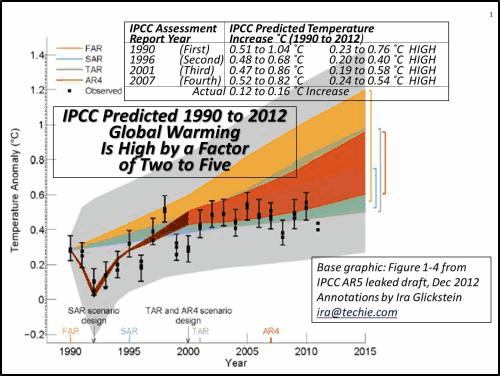File:Ipcc-ar5draft-fig-1-4.gif
Ipcc-ar5draft-fig-1-4.gif (500 × 376 pixels, file size: 668 KB, MIME type: image/gif, looped, 7 frames, 24 s)
Captions
Captions
Summary edit
| DescriptionIpcc-ar5draft-fig-1-4.gif |
English: Base graphic attribute to the leaked AR-5 report, dated December 2012
Annotations to Ira Glickstein. The creator of the Annotations Ira Glickstein says the following about the Graph: "The animated graphic is based on Figure 1-4 from the recently leaked IPCC AR5 draft document. … The animation shows arrows representing the central estimates of how much the IPCC officially predicted the Earth surface temperature “anomaly” would increase from 1990 to 2012. The estimates are from the First Assessment Report (FAR-1990), the Second (SAR-1996), the Third (TAR-2001), and the Fourth (AR4-2007). Each arrow is aimed at the center of its corresponding colored “whisker” at the right edge of the base figure. The circle at the tail of each arrow indicates the Global temperature in the year the given assessment report was issued. The first head on each arrow represents the central IPCC prediction for 2012. They all mispredict warming from 1990 to 2012 by a factor of two to three. The dashed line and second arrow head represents the central IPCC predictions for 2015. Actual Global Warming, from 1990 to 2012 (indicated by black bars in the base graphic) varies from year to year. However, net warming between 1990 and 2012 is in the range of 0.12 to 0.16˚C (indicated by the black arrow in the animation). The central predictions from the four reports (indicated by the colored arrows in the animation) range from 0.3˚C to 0.5˚C, which is about two to five times greater than actual measured net warming. The colored bands in the base IPCC graphic indicate the 90% range of uncertainty above and below the central predictions calculated by the IPCC when they issued the assessment reports. 90% certainty means there is only one chance in ten the actual observations will fall outside the colored bands. The IPCC has issued four reports, so, given 90% certainty for each report, there should be only one chance in 10,000 (ten times ten times ten times ten) that they got it wrong four times in a row. But they did! Please note that the colored bands, wide as they are, do not go low enough to contain the actual observations for Global Temperature reported by the IPCC for 2012." http://wattsupwiththat.com/2012/12/19/an-animated-analysis-of-the-ipcc-ar5-graph-shows-ipcc-analysis-methodology-and-computer-models-are-seriously-flawed/ The leaked AR-5 report, dated December 2012, says this about the Base Graph: "Estimated changes in the observed globally and annually averaged surface temperature (in °C) since 1990 compared with the range of projections from the previous IPCC assessments. Values are aligned to match the average observed value at 1990. Observed global annual temperature change, relative to 1961–1990, is shown as black squares (NASA (updated from Hansen et al., 2010; data available at http://data.giss.nasa.gov/gistemp/); NOAA (updated from Smith et al., 2008; data available at http://www.ncdc.noaa.gov/cmb-faq/anomalies.html#grid); and the UK Hadley Centre (Morice et al., 2012; data available at http://www.metoffice.gov.uk/hadobs/hadcrut4/) reanalyses). Whiskers indicate the 90% uncertainty range of the Morice et al. (2012) dataset from measurement and sampling, bias and coverage (see Appendix for methods). The coloured shading shows the projected range of global annual mean near surface temperature change from 1990 to 2015 for models used in FAR (Scenario D and business-as-usual), SAR (IS92c/1.5 and IS92e/4.5), TAR (full range of TAR Figure 9.13(b) based on the GFDL_R15_a and DOE PCM parameter settings), and AR4 (A1B and A1T). The 90% uncertainty estimate due to observational uncertainty and internal variability based on the HadCRUT4 temperature data for 1951-1980 is depicted by the grey shading. Moreover, the publication years of the assessment reports and the scenario design are shown." http://wattsupwiththat.com/2012/12/14/the-real-ipcc-ar5-draft-bombshell-plus-a-poll/ Statistical comment: The black annotation line labelled "actual" appears to be a straight line fitted by Ira Glickstein through the observed temperatures (black boxes with whiskers). The black boxes do not appear to lie on or near a straight line. The arithmetic of the fitting method is not specified. The fitting of the other annotation lines appears to assume that the probabilities in the 90% confidence intervals are symmetrically-distributed; there is not statement that this is the case (see violin plot). "Getting it wrong" seems to have been defined as the black annotation line not lying inside the coloured bands (prediction ranges), not in terms of the observations lying outside the prediction ranges. The 1-in-10,000 calculation firstly assumes that the IPCC's estimates in sequential reports were independent of one another, and secondly, it makes the prosecutor's fallacy. Natural variability is not mentioned in the annotations (see global effects of the 1991 eruption of Mount Pinatubo). |
| Date | |
| Source | ira _at_ techie.com |
| Author | Ira Glickstein |
| Other versions | original graph needed |
Licensing edit
- You are free:
- to share – to copy, distribute and transmit the work
- to remix – to adapt the work
- Under the following conditions:
- attribution – You must give appropriate credit, provide a link to the license, and indicate if changes were made. You may do so in any reasonable manner, but not in any way that suggests the licensor endorses you or your use.
- share alike – If you remix, transform, or build upon the material, you must distribute your contributions under the same or compatible license as the original.
File history
Click on a date/time to view the file as it appeared at that time.
| Date/Time | Thumbnail | Dimensions | User | Comment | |
|---|---|---|---|---|---|
| current | 15:32, 15 May 2013 |  | 500 × 376 (668 KB) | Nsaa (talk | contribs) | User created page with UploadWizard |
You cannot overwrite this file.
File usage on Commons
There are no pages that use this file.
File usage on other wikis
The following other wikis use this file:
